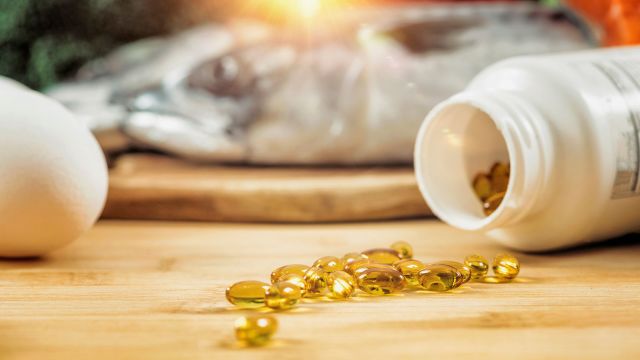Bone health is vitamin D’s primary claim to fame but during the pandemic the nutrient’s protective effective against the coronavirus have been under investigation. New research adds to mounting evidence that vitamin D deficiency is associated with a higher risk for severe COVID and death from the disease.
A February 2022 study published in PLOS ONE found a link between low vitamin D levels and severe disease or death from COVID-19. Researchers in Israel examined the hospital records of 1,176 people with severe infections but narrowed their focus to 253 patients who had their vitamin D levels measured prior to hospitalization. Since infection can lead to lower vitamin D levels, they relied on blood tests taken between two weeks and two years earlier.
The study found that those with vitamin D deficiency (less than 20 ng/mL) were 14 times more likely to have severe COVID than those with levels considered to be on the high end of the normal range (more than 40 ng/mL). Moreover, death rates among those with adequate vitamin D levels was 2.3 percent compared to 25.6 percent among the group with low levels of the nutrient.
Even after taking the patients age, sex, health history and the time of year into account, the study found that vitamin D levels had a strong correlation with COVID severity.
“Our results suggest that it is advisable to maintain normal levels of vitamin D. This will be beneficial to those who contract the virus," said the study’s leader, Amiel Dror, MD, PhD, of the Galilee Medical Center and Azrieli Faculty of Medicine of Bar-Ilan University in a news release. "There is a clear consensus for vitamin D supplementation on a regular basis as advised by local health authorities as well as global health organizations."
But why? What does vitamin D have to do with COVID? Understanding more about this essential nutrient can help shed light on why it might help protect against COVID—and a range of other health issues.
Vitamin D really isn’t a vitamin
It’s true. Vitamin D is what’s called a prohormone—a substance the body converts to a hormone.
And unlike other vitamins, such as C and A, which are readily found in a wide range of fruits and vegetables, only about 10 percent of the vitamin D you need comes from food. In fact, it’s found only in small amounts in relatively few food sources, including fatty fish, such as tuna, salmon or sardines, and some dairy products, including egg yolks and cheese.
Milk, orange juice and other fortified foods and beverages provide most of the vitamin D in the American diet.
With some help from the sun, your body makes most of the vitamin D it needs. Its production is triggered when the sun’s ultraviolet (UV) rays hit your skin. That’s why the time of year, where you live, your skin tone, age and sunscreen usage and wearing sun-protective clothing could all affect your vitamin D levels.
“If you’re living north of Atlanta, you’re far enough from the equator that you usually are not going to get enough vitamin D from routine exposure to sunlight,” says Joseph A. Aloi, MD, a professor of endocrinology and metabolism at the Wake Forest School of Medicine in Winston-Salem, North Carolina.
“You need 15 to 20 minutes a day of what I say is ‘bathing-suit exposure. Most of us aren’t getting that out gardening in hat and sleeves,” Dr. Aloi adds.
Moreover, dark-skinned people do not make as much vitamin D from sunlight exposure as fair-skinned people, Aloi notes. The melanin in dark skin blocks harmful UV rays, providing more protection against sun damage and skin cancer but allowing for less vitamin D production.
People who cover more skin with clothing also make less vitamin D. Older people may be deficient as well because skin doesn’t make vitamin D as efficiently over time. Those who are obese may not get enough because body fat may prevent some vitamin D from getting into the blood. And, perhaps unsurprisingly, deficiencies are more widespread during the darker, shorter days of winter.
Due to concerns about skin cancer, however, the American Academy of Dermatology still recommends against using sun exposure to obtain vitamin D, advising instead that people get enough from their diet and supplements.
Vitamin D’s possible benefits
Many people link vitamin D to strong bones. It does help the body absorb calcium, which helps build and maintain bones. But its benefits don’t end there. Vitamin D also promotes calcium absorption in the intestines and allows the kidneys to control blood calcium levels as well. It plays a role in cell growth and muscle strength, helps support the immune system and eases inflammation.
On the flip side, vitamin D deficiency has been linked to a variety of health issues. These include mood disorders, as well as bone conditions, diabetes, obesity, multiple sclerosis, heart disease and being at greater risk for infection.
In children, vitamin D deficiency can result in soft bones—a rare disorder called rickets. In adults, vitamin D deficiency can lead to osteomalacia, or the softening of bones.
Low levels of vitamin D may also lead older people to develop weak or brittle bones that break more easily—a condition called osteoporosis.
So, what about COVID?
Generally, vitamin D could reduce the risk of upper respiratory viral infection. It supports the production of antimicrobial proteins in the cells lining the respiratory tract. It also helps regulate the body’s inflammatory response to infection.
These beneficial properties led some experts to suggest that taking vitamin D supplements during the pandemic could have a protective effect against COVID.
A June 2020 study published in the American Journal of Infection Control also found that death rates from COVID-19 are lower in areas closer to the equator, where ultraviolet light is most intense and where the body can most readily produce vitamin D.
But the relationship between vitamin D is still not clear and remains under investigation. Other studies have found a variety of sometimes conflicting results. Larger, more well-designed studies should help shed light on the topic over time.
In the meantime, how much do you need?
There is still a lot we don’t know about vitamin D, including exactly how much people should get on a daily basis, according to Aloi.
“We’re really not sure what a normal serum vitamin D level is for optimal health,” he says.
Just as specialists disagree on whether sun exposure is advisable, there is also disagreement about optimal levels of vitamin D in the bloodstream. That’s in part because methods and precision vary from one lab to another.
“The question is whether the serum vitamin D blood level is an adequate measure of total body vitamin D,” Aloi explains. For that reason, he says, “our lab doesn’t list vitamin D as normal or abnormal. They list it as ‘sufficient’ or ‘insufficient.’”
In general, levels below 12 nanograms per milliliter (ng/mL) are too low for bone or overall health. Levels above 20 ng/mL are sufficient for most people, and levels above 50 ng/mL are probably too high.
For most purposes, Aloi says, “the range I’m looking for is 30-50, so that we don’t overshoot. With that, I think we’ve optimized bone health and probably everything else falls into place.”
Should you take a supplement?
It’s still unclear if taking a vitamin D supplement will help protect otherwise healthy people against COVID.
Routine supplementation with vitamin D alone has also not been shown to prolong life or cut the risk for heart disease or cancer. There are currently several trials underway to determine if taking vitamin D alone or with calcium could help reduce the risk for fractures.
Trials assessing the possible benefits of vitamin D supplements for the management of depression, fatigue, arthritis and chronic pain have been disappointing.
And when it comes to vitamin D, more is not necessarily better. Excess amounts could lead to high calcium levels in the blood or urine, kidney stones, calcifications in the body’s soft tissues and damage to the heart or kidneys.
Warning signs of vitamin D toxicity include:
- Weight loss
- Excessive urination
- Abnormal heart rhythms
For people using over-the-counter vitamin D supplements as directed, however, the risk of toxicity is low, Aloi notes.
“My general recommendation for patients,” he says, “is that if you’re taking 2,000 international units (IU) per day of vitamin D, which you can easily get over the counter, you are unlikely to take too much.”







